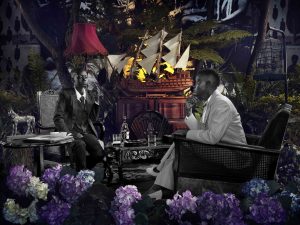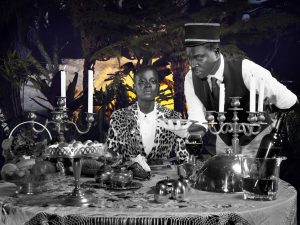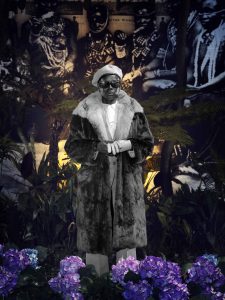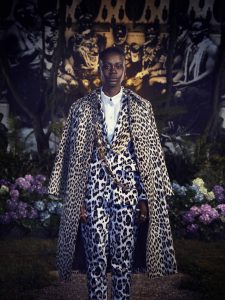We Still Insist is a film project and live performance presented by The Library of Things We Forgot to Remember and What’s Wrong With Groovin’? A visual and audio archive installation that speaks to the history of oppression, resistance and liberation throughout Africa in the latter half of the twentieth century, We Still Insist, is a collaborative meditation on transnational histories of Black resistance in opposition to racialised historical terror.
As I prepare for my conversation with two of the intervention’s collaborators, Tumi Mogorosi and Kudzanai Chiurai, I think of a written utterance from Christina Sharpe’s In the Wake – On Blackness and Being, “The distance of Black subjection was and is planned; terror is a disaster and ‘terror has a history’ and it is deeply atemporal.”
We Still Insist is a re-adaptation of Max Roach’s We Insist: Max Roach’s Freedom Now Suite avant-garde jazz album and a vocal-instrumental suite on themes related to the Civil Rights Movement. First recorded in 1960, the 1973 performance of the We Insist! Freedom Now (Uhuru Sasa) begins with Tears for Johannesburg Narration Part I: ‘Unto you a child is born’ — the past speaking to a future already and not yet formed.
Taking place on the 22nd of September at Constitution Hill, We Still Insist, also includes The Freedom Now Suite, made up of some of South Africa’s contemporary jazz greats and DJ Kenzhero.
Below is my conversation with Tumi and Kudzi ahead of the performance. Click here for tickets.

Lindi Mngxitama: Thinking through your collaboration, We Still Insist, which you’ve languaged as:
“A presentation of a visual and audio archive installation that speaks to the history of oppression, resistance and liberation throughout Africa in the latter half of the twentieth century.”
I was led back to one of Arthur Jafa’s interviews, where speaking about one of his works he says:
We want to explore what it is — not literally what it is just in terms of what is the content of the image — but what kinda form it is, what sort of medium it is… I was very clear from the beginning, I remember I said, “I wanna see what happens when you crossbreed, so to speak, a J.M.W Turner painting and a John Coltrane solo.” I mean one is visual, the other auditory but what does it mean to cross those things together? To mix them?
There are various levels and workings of crossbreeding, so to speak, happening in and with We Still Insist. A mixing of your own practice, its impulse/intentions and that of Kudzanai’s; a crossbreeding of the different forms that hold and give shape to your work; and a crossbreeding of geo-political contexts and histories. The one which gave life to Max Roaches’ We Insist and the one which gives life to We Still Insist.
What do you think has been made possible and has come out of these mixings through We Still Insist?
Kudzanai Chiurai: I think Arthur Jafa is actually correct, I think it’s a brilliant example of that idea of kind of crossbreeding. I think it works really well because it’s trying to see a particular experience without time — so like the past, present and the future happening simultaneously. So that was like part of the approach to We Still Insist, to see the past and present held within the same space, held within the same conversation, that was the thinking around We Still Insist. So, it is an idea about crossbreeding, which is very accurate when you refer to Arthur Jafa and his statement, it’s an attempt at that in some sense, as I said to see the past and present at the same time.
Tumi Mogorosi: I think what this collaboration has made possible is enlarging the communal voice that speaks about these kinds of social issues. I think it has afforded us a sort of enlarged communal sense, or it has brought voices that didn’t seem like they were speaking to each other together in one chorus. I think essentially these kinds of projects help, you know, to make the circle bigger and it’s been a pleasure to be able to be in conversation with Kudzi and Kenny around this project.

Lindi Mngxitama: Writing about Tshepang Ramoba and Team Sunday’s Everybody Talks Technique, I called upon the words of Writer and iNyanga Vuyiswa Xekatwane where she states:
Beyond the crime, unemployment and lack of resources the hood raises us for community. Many mornings my mother would send me to one of the many houses in our street to ask for anything from R10 for transport to those massive enamel dishes for umsebenzi… I never came back empty handed…For all their sombreness, funerals reflect more poignantly what community means in black spaces. It means ride or die, it means ‘I don’t have much but this is what I can give’, it means the whole is greater than the sum of its parts. Community in the hood is a kind of Ubuntu that you cannot commodify or perform.
I think of collaboration, community — and what moves in those spaces — as techniques and modalities of radical resistance and life making, particularly where Black folk are concerned. What space and role did collaboration and community occupy and play in the conceptualising and making of We Still Insist?
Kudzanai Chiurai: Since this particular project is one that is through the Library of Things We Forgot to Remember, one of the important premises of the library is that what is central to it is ideas around solidarity, collaboration and resistance, and this is an essential part of what you find within the archives of the library, as the material we hold covers a period of 1960s to 1985 and a period that also really significant as it marks a change and a political reformation of African independence.
But this was achieved by a process of solidarity, collaboration and within that resistance. So, the project We Still Insist is also an engagement of that, it’s a conversation about solidarity, collaboration and resistance. I think it’s not just something that you’d find, with this particular project the album itself by Max Roach, Abbey Lincoln — We Insist — characterises, or emphasises, or explores the ideas that reflect solidarity, collaboration and resistance.
It was at a time where the album was responding to legislated racism, there were the sit ins and bus boycotts happening in the US and at the same time African countries were gaining independence. So it was almost like, in part to say ‘we also insist on these freedoms’, but then not only in the US or in Africa but it was almost like a transnational community of thought that I think affected the Global South where independence was not negotiable, and through that it was a communal effort that everyone had invested in to achieve a sense of independence.
Tumi Mogorosi: I mean, for me collaboration is everything and I think with this project, We Still Insist, the collaboration aspect is at the forefront, of course with the visuals and and the sonic but also the way that we talk through the music itself. I had made a couple of arrangements of the songs, sort of like re-inhabiting the same kind of structural implications of the songs themselves — which is the blues — but then with that same sort of arrangement, we thought through a communal process which included Kenny on the 1 & 2s and of course incorporating other musicians that already have a voice of their own.
So I mean, I think this is an interesting space to explore ideas that were compositionally put down in the 1960s but what I tried to do with the rearrangement of these compositional ideas, I think was open up a space where we can all meet as the ensemble.

Portrait of Tumi Mogorosi
Lindi Mngxitama: I think there is something about collaboration that requires one to be open to the space of improvisation, and with that comes a turning towards courage. I’m also thinking about the philosopher Lao Tzu’s assertion that “from caring comes courage”, and I can’t help but think of caring as a relative of love.
As much as We Still Insist “speaks to the history of oppression, resistance and liberation throughout Africa in the latter part of the 20th century”, does it also have something to say about histories of — collective Black love — as practices of resistance and ontological undying?
Kudzanai Chiurai: Yes, I think, resistance, solidarity and collaboration embody collective Black love considerably and I think it’s something important to reflect upon as I think that in so much of what we consider resistance to be, love is so often excluded from that conversation. So, yes I do agree with you that it embodies that and I think that as these memories, or the experience of legislated racism and dispossession, there’s a collective experience within Black and brown communities globally.
So, the response to that is one that is communal and reflects a community of love and love extended, not just in a localised direction but one that is expansive by experience, by the sense of that resistance, and that is carried out and found within resistance movements and political parties and intellectuals.
Tumi Mogorosi: The history of resistance itself, is a history of Black love. I think there won’t be any sort of historical narrative around resistance if the people didn’t love themselves, and I think this is the precondition of a dream of being free or of working towards the space where one can be free.
I think all of these are acts of revolutionary love, I also think that love is the precondition for all these things that come by way of the historical narrative of Black resistance.

Portrait of Kudzanai Chiurai
Lindi Mngxitama: While reading her piece The Music of the Spheres — which discusses natural and unnatural phenomena, the Black Panthers and cointelpro at the Loophole of Retreat Conference hosted by the Guggenheim museum on April 27th 2018 Sharifa Rhodes-Pitts laments:
There is a field. Some say this is where memory resides, not in the body, nor hovering above the place where an action unfolded organically. Yet, it goes where we go. To enter the field is to be in the midst of that which is imperceptible, incessant, without known origin, without end. But it can be changed. Does the hum still sound?
If we think about memory as a history of interiority and the felt sense — and if we think about We Still Insist as a kind of field like the one Rhodes-Pitts is speaking about — what hum do we hear sounding when we enter into it, and what does it have to say about Black people, the future and Black people in the future?
Kudzanai Chiurai: I think that with the history of legislated racism, dispossession and white supremacy, those experiences are then embodied — whether it was our parents or our grandparents, our uncles or aunts — that experience of legislated racism kind of lives with them. I think for the generation that comes after, it’s dealing with the aftermath of infrastructure and institutions that embody legislated racism, white supremacy and dispossession.
So, I think, that we still live with within our communities and we are constantly undoing legislation that defined a particular period, defined resistance, and I think that resistance remains in this undoing process. So, in some respect that undoing, I think, we almost still live in colonial futures as opposed to the post-colony. So, up-until a point where these colonial futures that remain with us, I guess we still insist — on our freedom, on our sense of dignity. And until within the spaces we live and navigate, we don’t have to negotiate anymore.
Tumi Mogorosi: What one hears is a long history of accumulated sounds that are striving for freedom, and this I guess is that space where Black futurity itself is precarious because of the moments it inhabits, that still sort of project this wish for freedom. And I think that Black futurity is, like Zim Ngqawana said, when we are silent about these things.
So, I think Black music is a precondition to end the idea of Black music itself, because Black music speaks from a positionality that speaks about freedom, and once freedom is attained I think what happens is that blackness ceases to exist. I think this is a really critical point around the emancipation of a historical accumulation in terms of the characteristics of what being Black is in the world.

The Freedom Now Suite is made up of:
Tumi Mogorosi: Drums
Gabi Motuba: Vocals
Dalisu Ndlazi: Bass
DJKenzhero: on the 1’ns & Two’s
Malcolm Jiyane: Trombone
Ndabo Zulu: Trumpet
Ofenste Sebula: Tenor Sax
Gontse Makhene: Percussions
Robin Fassie: Trumpet






















































